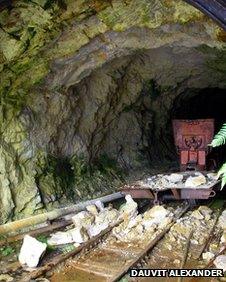Loch Lomond national park approves Cononish gold mine
- Published
Chris Sangster shows Lorna Gordon inside the proposed mine
Plans to develop Scotland's first commercial gold mine in Loch Lomond National Park have been approved.
Members of the park authority's board said the opportunities for new jobs and economic growth outweighed concerns about the environment.
But the board insisted Scotgold Resources, who will develop the mine at Cononish, should make sure the long-term environmental impact is minimised.
It is the firm's second attempt at securing planning permission.
The first application was rejected by the Loch Lomond National Park Authority over conservation concerns.
Scotgold Resources plans to extract more then £50m worth of gold and silver from a hillside near Tyndrum.
It has been 500 years since gold was successfully mined in Scotland, but the high price of precious metals now makes the work cost-effective.
'Loss of character'
After failing to secure planning permission with its first bid, Scotgold Resources submitted revised plans in July this year, after dropping an appeal.
National Park convener Linda McKay said it was "without question" the most complicated planning application the park had ever considered.
"As guardians of some of the most stunning scenery in Scotland, it would have been easy to refuse the second application if we were considering the short-term impact on the landscape, but this National Park plans for long-term conservation management and that includes having the vision to see beyond the temporary life of the gold mine," she said.
"Overall, as a board we understand that there will be a temporary loss to Glen Cononish's special character, but we have greater confidence that we can secure both long-term conservation gain and economic benefits to the local economy and Scotland."
Ms McKay said the national park had also taken into consideration the fact that the local community council had backed the proposals.
Scotgold Resources said about 50 jobs would be created, and it has promised to restore the landscape at the end of its 10-year licence.
'Legally binding'
The firm's first application was refused mainly because of concerns over how the 820,000 tonnes of spoil extracted from the mine would be managed.
But the national park said the company had redesigned its "tailings management facility" to fit in with the landscape and halved its size.
Ms McKay added: "We also have a 30-year commitment to improve the wider Glen Cononish.

The gold mine is at Cononish near Tyndrum
"The Greater Cononish Glen management plan will include extending existing native Caledonian pine forest and improving habitats and access tracks.
"This legally binding agreement means the glen will regain its quiet, remote character following closure of the mine and the landscape will be improved from its current state."
Scotgold Resources said the mine was expected to produce about 20,000 ounces of gold and 80,000 ounces of silver a year.
About 5,000 ounces of the gold will be extracted as unrefined bars and identifiable as "Scottish gold" - which can attract a premium because of its scarcity.
Scotgold's chief executive officer Chris Sangster said: "We are delighted with the decision from the park's board in approving the executive director's recommendation.
"This represents the culmination of three years' detailed work towards planning a mining development which meets the exacting environmental standards required by the National Park Authority."
The plan for the gold mine has gathered considerable local support, but concern was raised over whether the surface workings could spoil the approach to the 1,130m (3,707ft) Ben Lui.
Chris Townsend, outdoors writer and ex-president of the Mountaineering Council of Scotland, said: "I hope the damage is minimal and access for mountaineers isn't restricted."
- Published13 October 2011
- Published26 August 2011
- Published20 July 2011
- Published19 April 2011
- Published29 March 2011
- Published19 January 2011
- Published22 December 2010